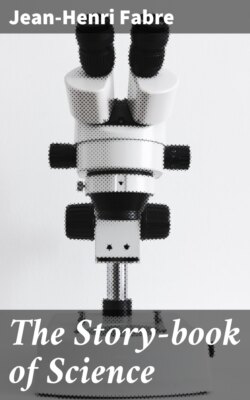Читать книгу The Story-book of Science - Fabre Jean-Henri - Страница 11
CHAPTER VIII
THE OLD PEAR-TREE
ОглавлениеUNCLE PAUL had just cut down a pear-tree in the garden. The tree was old, its trunk ravaged by worms, and for several years it had not borne any fruit. It was to be replaced by another. The children found their Uncle Paul seated on the trunk of the pear-tree. He was looking attentively at something. “One, two, three, four, five,” said he, tapping with his finger upon the cross-section of the felled tree. What was he counting?
“Come quick,” he called, “come; the pear-tree is waiting to tell you its story. It seems to have some curious things to tell you.”
The children burst out laughing.
“And what does the old pear-tree wish to tell us?” asked Jules.
“Look here, at the cut which I was careful to make very clean with the ax. Don’t you see some rings in the wood, rings which begin around the marrow and keep getting larger and larger until they reach the bark?”
“I see them,” Jules replied; “they are rings fitted one inside another.”
“It looks a little like the circles that come just after throwing a stone into the water,” remarked Claire.
“I see them too by looking closely,” chimed in Emile.
“I must tell you,” continued Uncle Paul, “that those circles are called annual layers. Why annual, if you please? Because one is formed every year; one only, understand, neither more nor less. The learned who spend their lives studying plants, and who are called botanists, tell us that no doubt is possible on that point. From the moment the little tree springs from the seed to the time when the old tree dies, every year there is formed a ring, a layer of wood. This understood, let us count the layers of our pear-tree.”
Uncle Paul took a pin to guide his counting; Emile, Jules, and Claire looked on attentively. One, two, three, four, five—They counted thus up to forty-five, from the marrow to the bark.
“The trunk has forty-five layers of wood,” announced Uncle Paul. “Who can tell me what that signifies? How old is the pear-tree?”
“That is not very hard,” answered Jules, “after what you have just told us. As it makes one ring every year, and we have counted forty-five, the pear-tree must be forty-five years old.”
“Eh! Eh! what did I tell you?” cried Uncle Paul, in triumph. “Has not the pear-tree talked? It has begun its history by telling us its age. Truly, the tree is forty-five years old.”
“What a singular thing!” Jules exclaimed. “You can know the age of a tree as if you saw its birth. You count the layers of wood; so many layers, so many years. One must be with you, Uncle, to learn those things. And the other trees, oak, beech, chestnut, do they do the same?”
“Absolutely the same. In our country every tree counts one year for each layer. Count its layers and you have its age.”
“Oh! how sorry I am I did not know that the other day,” put in Emile, “when they cut down the big beech which was in the way on the edge of the road. Oh, my! What a fine tree! It covered a whole field with its branches. It must have been very old.”
“Not very,” said Uncle Paul. “I counted its layers; it had one hundred and seventy.”
“One hundred and seventy, Uncle Paul! Honest and truly?”
“Honest and truly, my little friend, one hundred and seventy.”
“Then the beech was a hundred and seventy years old,” said Jules. “Is it possible? A tree to grow so old! And no doubt it would have lived many years longer if the road-mender had not had it cut down to widen the road.”
“For us, a hundred and seventy years would certainly be a great age,” assented his uncle; “no one lives so long. For a tree it is very little. Let us sit down in the shade. I have more to tell you about the age of trees.”
